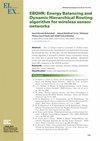一种用于永磁同步电机模型预测控制的优化算法
IF 0.8
4区 工程技术
Q4 ENGINEERING, ELECTRICAL & ELECTRONIC
引用次数: 0
摘要
为了提高永磁同步电动机的运行性能,提出了一种新的电压优化算法。该算法以粒子群算法为基础,结合了在线优化和二次优化两方面的改进。将改进的粒子群算法(IPSO)应用于双矢量模型预测控制(DVMPCC)进行仿真和实验研究。结果表明,在速度响应相似的情况下,与DVMPCC相比,电流纹波减小了16.22%,稳态速度波动减小了65.14%。这表明所提出的算法是可行的,有效地提高了系统的运行性能。本文章由计算机程序翻译,如有差异,请以英文原文为准。
An optimization algorithm used in PMSM model predictive control
To improve the operational performance of Permanent Magnet Synchronous Motors (PMSM), a new voltage optimization algorithm is proposed. This algorithm is based on Particle Swarm Optimization (PSO) and incorporates two improvements: online optimization and secondary optimization. The improved PSO (IPSO) algorithm is applied to Dual-Vector Model Predictive Control (DVMPCC) for simulation and experimental research. The results show that, compared to DVMPCC, with similar speed response, the current ripple is reduced by 16.22% and the steady-state speed fluctuation is reduced by 65.14%. This indicates that the proposed algorithm is feasible and effectively improves the operational performance of the system.
求助全文
通过发布文献求助,成功后即可免费获取论文全文。
去求助
来源期刊

Ieice Electronics Express
工程技术-工程:电子与电气
CiteScore
1.50
自引率
37.50%
发文量
119
审稿时长
1.1 months
期刊介绍:
An aim of ELEX is rapid publication of original, peer-reviewed short papers that treat the field of modern electronics and electrical engineering. The boundaries of acceptable fields are not strictly delimited and they are flexibly varied to reflect trends of the fields. The scope of ELEX has mainly been focused on device and circuit technologies. Current appropriate topics include:
- Integrated optoelectronics (lasers and optoelectronic devices, silicon photonics, planar lightwave circuits, polymer optical circuits, etc.)
- Optical hardware (fiber optics, microwave photonics, optical interconnects, photonic signal processing, photonic integration and modules, optical sensing, etc.)
- Electromagnetic theory
- Microwave and millimeter-wave devices, circuits, and modules
- THz devices, circuits and modules
- Electron devices, circuits and modules (silicon, compound semiconductor, organic and novel materials)
- Integrated circuits (memory, logic, analog, RF, sensor)
- Power devices and circuits
- Micro- or nano-electromechanical systems
- Circuits and modules for storage
- Superconducting electronics
- Energy harvesting devices, circuits and modules
- Circuits and modules for electronic displays
- Circuits and modules for electronic instrumentation
- Devices, circuits and modules for IoT and biomedical applications
 求助内容:
求助内容: 应助结果提醒方式:
应助结果提醒方式:


